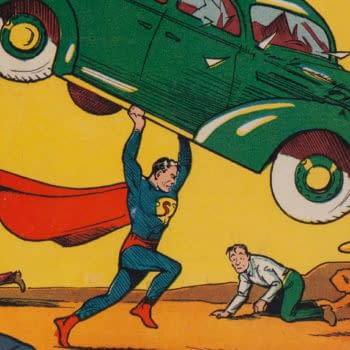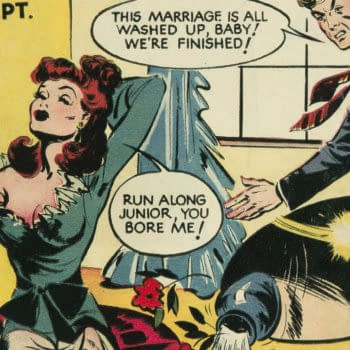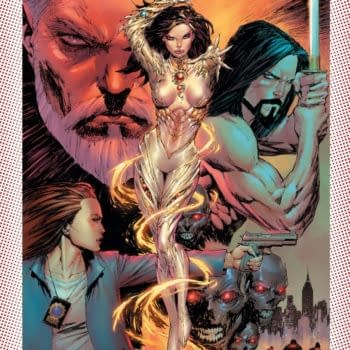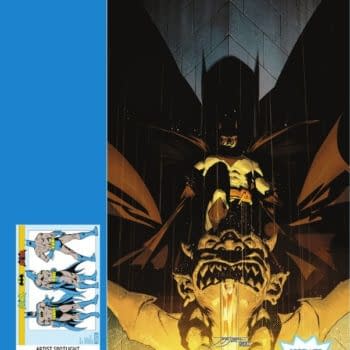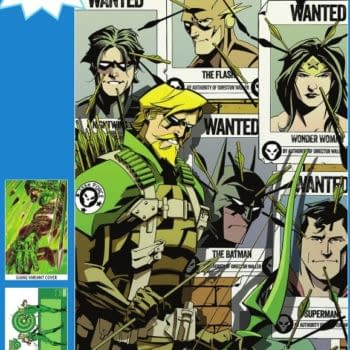Posted in: Comics, Heritage Sponsored, Vintage Paper | Tagged: golden age, green lantern, streak the wonder dog
The Debut of Streak the Wonder Dog in Green Lantern #30, at Auction
Streak the Wonder Dog was not the first dog hero of the Golden Age of comics. Bulletdog (Bulletman #10, cover-dated December 1942) and Rang-A-Tang (Blue Ribbon Comics #1, November 1939) among others came along earlier. But Streak did debut seven years before Krypto (Adventure Comics #210, March 1955), and his history and legacy have taken some interesting twists and turns. He essentially came to dominate the Green Lantern titles more than Green Lantern himself, and his debut in Green Lantern #30 is a much tougher get than you might think. An underappreciated DC Comics key, there's a Green Lantern #30 (DC, 1948) CGC Apparent GD+ 2.5 Slight (A) Off-white to white pages up for auction in the 2022 July 3-4 Sunday & Monday Comic Books Select Auction #122227 at Heritage Auctions.
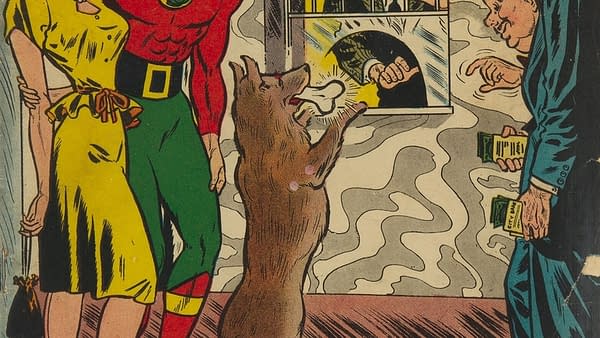
Streak appears to be at least in part inspired by the forgotten film dog star of the 1920s and 1930s, Silver Streak the Wonder Dog. Movie star Silver Streak was a brown-colored German Shepherd with a similar appearance to his comic book counterpart. While some other dog stars are often played for comedy, both Streak and Silver Streak were also sometimes depicted to be very aggressive in pursuit of comic book and film justice. Film titles like The Snarl of Hate and Fangs of Justice set the tone for the original Silver Streak's adventures.
As told in his origin story and debut in Green Lantern #30, Streak was born and grew up on a farm run by a woman named Sara. Streak helped watch over the farm, its animals, and Sara herself, keeping everyone safe from predators. Sara left the farm suddenly one day, leaving Streak in the care of her brother Luke, who was a forest ranger. Streak learned to aid Luke as he was helping people in various ways in his territory.
Sometime later, Luke got a letter from Sara and immediately left Streak behind in the care of a fellow forest ranger. But Streak deduced what was happening by smelling Sara's scent on the letter, and followed Luke's trail to Gotham City. Just as Streak finds Luke in Gotham City, Luke is gunned down by gangsters. Streak is also shot in the exchange, but is saved by Green Lantern. Soon, Streak finds Sara, who has been drugged by a war criminal named Dr. Malorgo, whom the world believes is dead. It is revealed that Sara is actually Captain Sara Dale, of U.S. counter-intelligence, who had been on Malorgo's trail during WWII and had been called back to service when it was discovered that he might be alive. Green Lantern and Streak are ultimately able to rescue Sara and defeat Dr. Malorgo.
Streak next appears in All-American Comics #96, two months later. After this, Green Lantern's decline at DC Comics became very evident. Streak became the dominant figure on the cover of All-American Comics #98, and Green Lantern lost his cover placement entirely beginning with issue #100, which was retitled All-American Western with issue #103. Streak dominated several of the covers of the Green Lantern series beginning with issue #34, and that title ended with issue #38. Then in 1952, the team who had created Streak the Wonder Dog in Green Lantern — Bob Kanigher and Alex Toth — rebooted their comic book pup for the post-superhero era into a white-furred former military K-9 Corps German Shepherd called Rex the Wonder Dog. Rex had his own series, which lasted for 46 bi-monthly issues through 1959.
Most accounts of Rex's backstory note that he's a rebooted version of Streak and also point out the similarity to a dog star of the film era of the 1920s. In total, this earlier movie dog star Rex appeared in about 28 films 1923-1930, and went on to become a performer in circuses, county fairs, and the like. When this Rex died in 1946, it was noted in newspapers across the country. Since "Rex" was a very popular name for dogs for many decades, and there's been more than one famous dog star named Rex besides that, the history of Rex the Wonder Dog has largely been left at that.
But then Rex's history was rebooted entirely, with the introduction of a real-life DC Comics-connected version. A small group of newspaper accounts in 1958 put a spotlight on a 'new' Rex the Wonder Dog. Some of these accounts claim that it was this Rex that actually inspired the DC Comics series. What's more, in addition to film and tv work, the new Rex the Wonder Dog actually appeared with Superman on some sort of traveling show tour which involved George Reeves as Superman — the star of the Adventures of Superman television series — and actor/stuntman Gene LaBelle, playing a character called "Mr. Kryptonite". The connection between this Rex and the comic book version seems to have been confirmed in a 1985 Gannett News Service syndicated story on the 50th Anniversary of DC Comics. The widely-seen piece notes that DC turned to comics featuring celebrities in the 1950s, including "Bob Hope, Jerry Lewis, Rex the Wonder Dog and Hopalong Cassidy."
A deep-dive piece on Rex in the January 29, 1958 issue of the Ithaca Journal (Ithaca, New York) headlined "Courageous Dog Outwits Reds, Reaches America" goes all-in on what seems to be the hero dog's dramatic real-life story. When the Hungarian Revolution broke out in late 1956, Rex helped 25 Hungarians evade Russian patrols as they all made their way to freedom. Rex, four years old in 1958, had recently made his way to America from his birth home in Hungary:
The crossing was made at night with Rex in the lead. Once on the Austrian side of the border, the refugees lighted their flashlights — only to draw gunfire from the Communists they had outwitted.
Shortly afterward, two men approached Bihari (Rex's owner) and urged him to bring Rex back into Hungary to lead another party to safety. But their poor Hungarian speech and their manner did not ring true. Bihari, suspecting them of being Communist agents, turned down the opportunity for Rex to become a dubious hero.
Although it had been considered dangerous to bring a dog on such a venture, Bihari learned that groups of refugees on either side of them had been discovered, captured, and shot. Without Rex, Bihari feels, there would be no story to tell, no promising career in the United States.
Interestingly, the details here generally track with the comic book origin of Rex from The Adventures of Rex the Wonder Dog #1 in 1952, which briefly explain that Rex had been "overseas", had been awarded a medal for bravery, and had been trained to help people in trouble. However, the Ithaca Journal story also contradicts the notion that this Rex inspired the comic book, since it launched in 1952, and Rex didn't arrive in the U.S. until 1957. Further, the "original" Rex passed away in 1946, so it's unlikely that he would've been part of a 1950s DC Comics push for celebrity or tv/film property-related comic books. It's possible that Rex's backstory was connected to Superman and DC Comics for its Cold War-era anti-Communist media message value.
Despite the arrival of the new Rex to America and a wide range of media and local event performances, The Adventures of Rex the Wonder Dog series ended in 1959. It is perhaps no coincidence that in the same month that the last issue of The Adventures of Rex the Wonder Dog hit the newsstand, Green Lantern returned in Showcase #22. The day of the dog stars was in decline, and it was time for the superheroes again. But the memory of DC Comics' original Wonder Dog Streak lives on. An often overlooked DC Comics key, there's a Green Lantern #30 (DC, 1948) CGC Apparent GD+ 2.5 Slight (A) Off-white to white pages up for auction in the 2022 July 3-4 Sunday & Monday Comic Books Select Auction #122227 at Heritage Auctions.
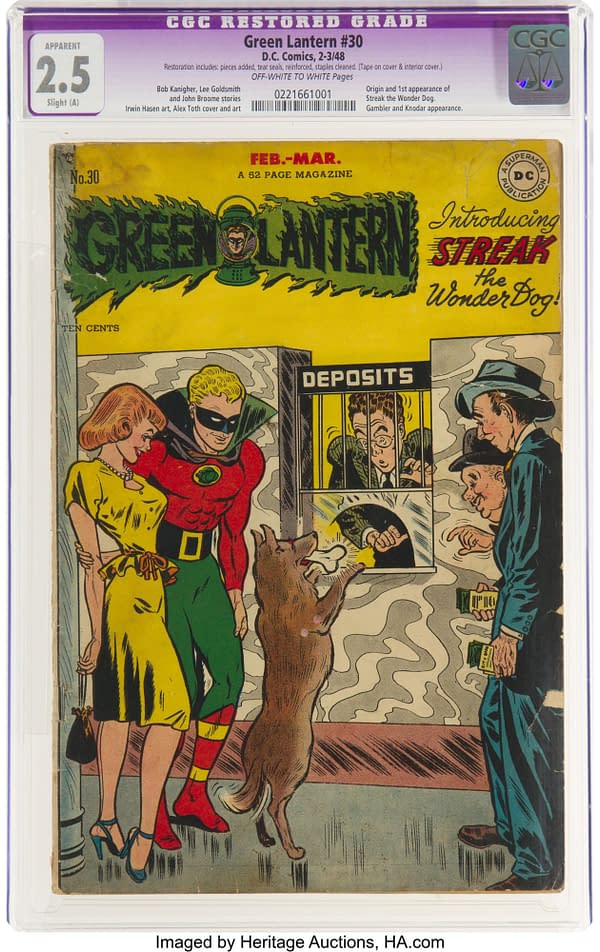
Green Lantern #30 (DC, 1948) CGC Apparent GD+ 2.5 Slight (A) Off-white to white pages. Overstreet lists this issue as "rare" and Gerber rates it a "7" ("scarce") in its Scarcity Index. Origin and first appearance of Streak the Wonder Dog. Alex Toth cover and art. Irwin Hasen art. CGC notes, "Restoration includes: pieces added, tear seals, reinforced, staples cleaned. (Tape on cover and interior cover.)" Overstreet 2021 GD 2.0 value = $423.





